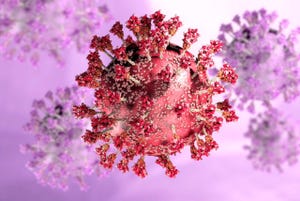Infection Control: Market Opportunity for Devices
May 1, 2007
NEWS TRENDS
|
Attaching respiratory suction wands to patients' beds minimizes exposure to contaminants. |
Infection control has been considered the province of cleaning and sterilization products. But now there are medical devices that address the problem, too. This could be a significant market, as hospital-acquired infections affect up to 2 million patients each year.
In other words, about one in 20 patients admitted to a hospital acquires an infection from something in the hospital. Clearly, cleaning and sterilization have not been enough.
One player in the device market was started by a hospital official who figured out the source of some of these infections and designed a technological solution. The device is one of several pioneers in this field that could lead the way in controlling the problem of hospital infections.
Clifford Wright was a biomedical engineer at Sharp Memorial Hospital in San Diego, where he was responsible for the evaluation and repair of medical devices. He specialized in the respiratory arena, and he noticed that suction wands were being left in inappropriate places, such as under a patient's pillow or on the floor. This presented a contamination issue. There had to be a way to isolate and contain contaminated wands, he thought.
So, in his garage, Wright designed a holster and bed rail clip, which provided a place to put wands—without exposing them to contaminants—when they were in a patient's room but not being used. Although a very simple idea, it turned out to be an extremely helpful one. Sharp and other hospitals expressed interest, and Wright formed Medical Device Group, which later changed its name to Iapyx Medical. It is dedicated to finding device-based solutions to infection and contamination problems in hospitals.
“This and other ideas are based on Wright's observations in the hospital; he'd start to think about how there should be a better way to do something,” says Josh Potratz, Iapyx's manager of public relations and corporate communications. “In the case of suction wands, he was able to identify a need that the market wasn't addressing.”
Catheter stabilization devices are another way to approach the problem of hospital-acquired infections. Securing urinary catheters, which have two branches, to a patient's leg had been a problem for years. This method resulted in urinary tract infections. So now there are devices that hold them in place. The market leader is Venetec International Inc., also based in San Diego. Its technology has proved so promising that in March, C. R. Bard Inc. (Murray Hill, NJ) agreed to purchase Venetec for $166 million.
Venetec has its roots in hospital biomedical engineering as well. Its founder, Steve Bierman, was assistant director of emergency services at Scripps Memorial Hospital in San Diego. He got the idea for a securement device after accidentally contracting Hepatitis B from a needlestick injury. It made him realize that the perils of vascular access, not solved by tape and suture solutions, can be solved with stabilization.
Iapyx, when it was Medical Device Group, introduced a catheter stabilization device of its own, but lost a patent infringement case to Venetec in 2005. It has since hit the market with a new design.
Copyright ©2007 Medical Device & Diagnostic Industry
About the Author(s)
You May Also Like



